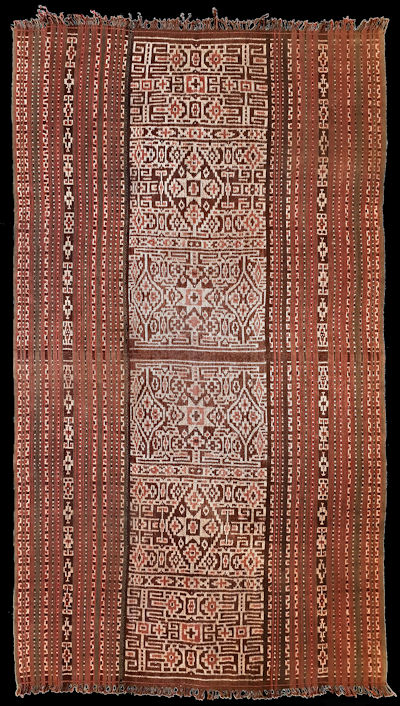| |
 
 | | | |
327 Timor, East Timor
Tais duka (shawl)  
| | Locale: | Suai-Loro | | Period: | 1920-1930 | | Yarn: | Cotton, hand-spun, fine | | Technique: | Warp ikat | | Panels: | 2 | | Size: | 96 x 170 cm (3' 1" x 5' 6") LW: 1.77 | | Weight: | 715 g (25.2 oz), 438 g/m2 (1.44 oz/ft2) | | Design: | Royal tais duka, acquired from Tamukung (local ruler) Vincen Luruk, made by his mother Teresia Luruk Bouk. The predominantly morinda red tais duka features a middle section covered with a maze of interlocking stepped squares, eight-pointed stars and lozenges, and is flanked by side panels composed of narrow stripes and bands of warp ikat. The corded fringes end in little pompons, like the 'clove flowers' of Semau. Remarkable is the asymmetry: all of the central field and the narrower of the wide lateral bands are one panel, the wider lateral band is a panel by itself. �� | | Comment: | The former rajadom of Suai on the south coast of Central Timor actively participated in regional maritime commerce that brought patola and other Indian trade textiles to the island. These cloths provided inspiration for locally-woven men�s cloths. Hand-spun yarn, natural dyes. Both the style and the weave type show great similarity to the men's wrap 327 and the sarong 328. When a cloth consists of a larger and a smaller panel, such as in this case, the larger is called older brother, maun (Ind. kakak), the smaller the younger brother, alin (Ind. adik). | | Background: | Chapters on Timor and East Timor. | | Exhibited: | Timor: Totems and Tokens, Museu do Oriente, Lisbon, 2019/20. | | Published: | Timor: Totems and Tokens, 2019.
Ikat from Timor and its Outer Islands, 2022.
Ikat Textiles of Timor: Indonesian and Timor-Leste, 2025. | | Compare: | 328 | | |

©Peter ten Hoopen, 2025
All rights reserved.
|
|


